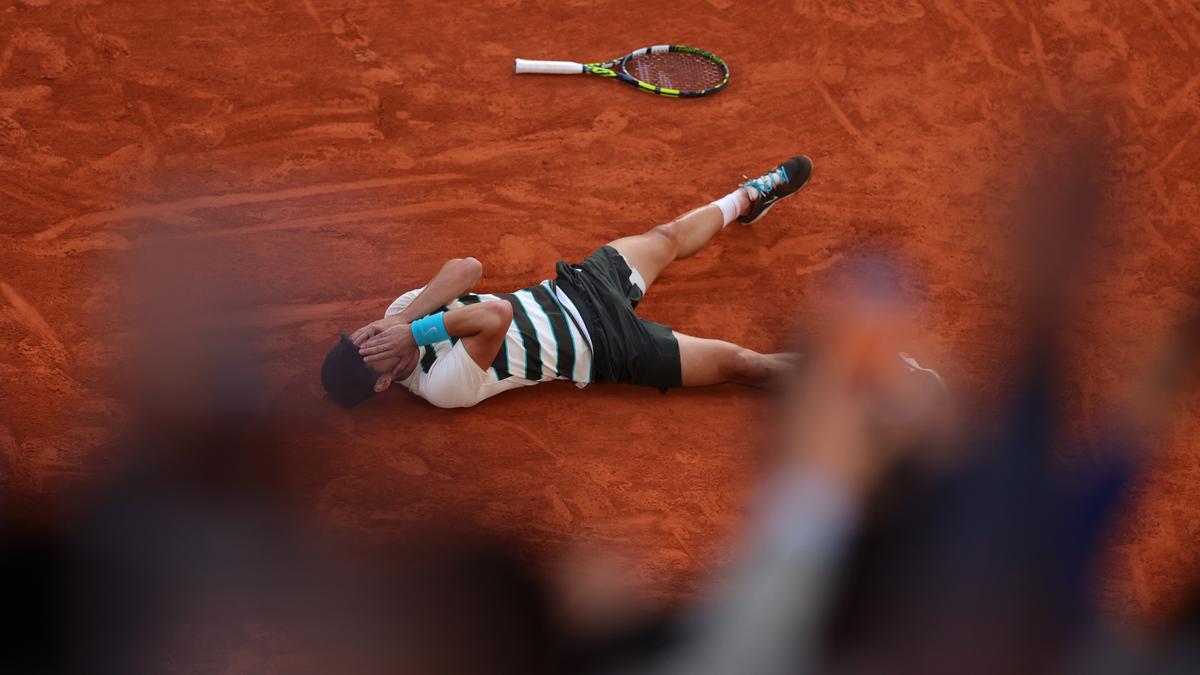What truly stood out on Sunday was Alcaraz’s extraordinary comeback from being two sets down.
| Photo Credit: JULIAN FINNEY
Grand Slam finals carry an unmistakable aura. When a Slam final stretches into a five-setter, it signifies an enthralling contest between evenly matched rivals. Add multiple tie-breakers into the mix, and the sense of parity intensifies, turning the match into an absorbing duel between superior equals. These epic battles become historic.
No fan can forget two such memorable men’s tennis finals from the recent past. The longest Grand Slam final ever in the Open Era — a gruelling 5-hour, 53-minute battle between Novak Djokovic and Rafael Nadal at the 2012 Australian Open — remains unmatched to this day. Djokers’ celebration, during which he tore off his shirt, remains etched in every tennis fan’s memory. Equally unforgettable is the memory of both the players, their legs trembling, at the trophy presentation, until someone brought them chairs.
The 2019 Wimbledon final between Djokovic and Roger Federer stood out for different reasons. Lasting 4 hours and 57 minutes, it became the first Slam final to feature three tie-breaks in the Open Era. The sight of Djokovic squatting on Centre Court and eating grass in triumph signalled not just victory, but also a poignant end to Federer’s legendary pursuit.
Sunday’s showdown at Roland Garros between World No. 1 Jannik Sinner and World No 2 Carlos Alcaraz has earned its place among the greatest Slam finals. Lasting 5 hours and 29 minutes, it is the second-longest Grand Slam final in the Open Era.
The chart shows the length in minutes for 122 Grand Slam Finals (data from 1991 to 2025). Each circle corresponds to a final. The higher the dots, the longer the finals. Interestingly, in recent years, matches have been relatively longer.
The gripping encounter also featured three tie-break sets — only the second time in Open Era Grand Slam finals. However, the number of tie-breaks should be viewed with caution, as rules have varied across years and Grand Slams.
The chart on the left shows the number of finals that featured three/two/ one/zero tie-break sets and the chart on the right shows the number of finals that featured five/four/three sets in the Open Era.
What truly stood out on Sunday was Alcaraz’s extraordinary comeback from being two sets down. To underscore just how rare this feat is: Sinner had only once before lost a match after winning the first two sets since 2021; that was against Djokovic at Wimbledon 2022. Indeed, in the Open Era, the number of times a player who was two sets behind and then went on to become the champion in a Grand Slam final is only eight.
The table shows eight other Grand Slam finals in the Open Era in which a player lost the first two sets, but eventually won.
Incredibly, the most recent occurrence before this was by Sinner himself, who fought back to win the 2024 Australian Open after trailing Daniil Medvedev by two sets. Medvedev, unfortunately, has experienced this twice — previously it was in 2022, against Nadal, in the Australian Open final.

On three defining measures — a marathon encounter, multiple tie-break drama, and an unforgettable comeback — the latest Roland Garros final emphatically earns its place among the greatest championship matches ever played.
The table shows the 12 finals that Jannik Sinner reached since 2024, with the winners and losers mentioned.
With 38-year-old Djokovic’s last Slam win happening in 2023, and Nadal and Federer now retired, tennis fans are eagerly turning their gaze towards Sinner and Alcaraz — the emerging rivals still in their 20s. Since 2024, Sinner has dominated the tour, winning 91 out of 99 matches (a 92% win rate), while Alcaraz, during the same period, has managed to win 91 out of 109 matches (a win rate relatively lower at 83%).

Yet there’s a twist. Since 2024, Alcaraz and Sinner have faced off five times — including three finals — and each time the Spaniard has emerged victorious. Sinner reached 12 finals in this period, winning all nine in which his opponent wasn’t Alcaraz (Table 4). While few have managed to solve the Sinner puzzle, Alcaraz, despite faltering against others, has maintained a flawless record against the Italian in the last 18 months.
The data for the charts were sourced from Tennis Abstract
Published – June 12, 2025 07:00 am IST
